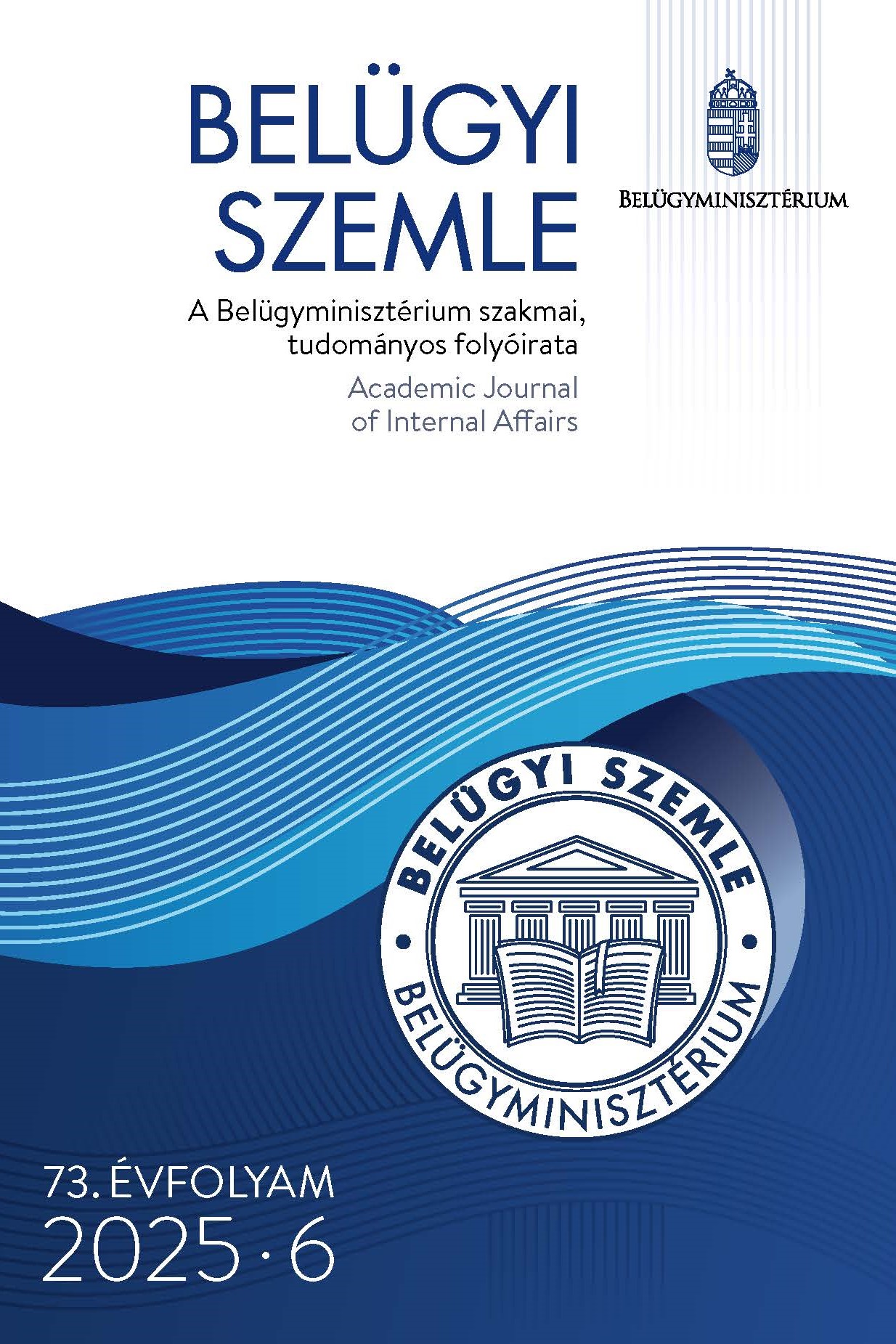Absztrakt
Cél: A tanulmányban szociológiai szempontból közelítik meg a szerzők a rendőri intézkedésekről készült felvételek felhasználásának gyakorlatát, bemutatva annak előnyeit és hátrányait egyaránt. Az Országos Rendőr-főkapitányság Kommunikációs Szolgálatának tájékoztatása szerint testkamerákat tesztelt a rendőrség. A rendőrségi testkamerák bevezetése nemcsak technológiai újítás, hanem olyan változás is, amely jelentősen befolyásolhatja a rendvédelmi szervek szervezeti kultúráját. Ennek okán jutottak a szerzők arra, hogy megvizsgálják, milyen hatása van a kamerafelvételeknek a rendőrség szervezeti kultúrájának alakításában.
Módszertan: A téma feldolgozásához a vonatkozó nemzetközi szakirodalom áttekintése, elemzése, valamint a hazai tapasztalatok és a szerzők gyakorlati munkájuk során szerzett személyes tapasztalásaik nyújtottak segítséget. A témát szociológiai aspektusból közelítették meg.
Megállapítások: A tanulmányban arra a következtetésre jutottak, hogy az „új láthatóság” és a rögzített felvételek felhasználásának tekintetében elegendő kutatás áll rendelkezésre, így hazánkban a testkamerák bevezetése előtt azok áttekintése és felhasználása elengedhetetlen.
Érték: A vizsgálat eredményei nemcsak a rendőri munkában, hanem a rendészeti szakemberek oktatásában és továbbképzésében is hasznosíthatók.
Hivatkozások
Balla, J. (2019). Integritási kockázatok csökkentése a határrendészek körében. Nemzeti Közszolgálati Egyetem.
Brighenti, A. (2007). Visibility: A category for the social sciences. Current sociology, 55(3), 323–342.
Cullen, F. T., Link, B. G., Travis, L. F. & Lemming, T. (1983). Paradox in policing: A note on perceptions of danger. Journal of Police Science & Administration, 11(4), 457–462.
Deuchar, R., Crichlow, V. J. & Fallik, S. W. (2020). Cops in crisis?: Ethnographic insights on a new era of politicization, activism, accountability, and change in transatlantic policing. Policing and society, 30(1), 47–64. https://doi.org/10.1080/10439463.2019.1584197
Doyle, A. (2006). An alternative current in surveillance and control: Broadcasting surveillance footage of crimes. In Haggerty, K. D. & Ericson, R. V. (Eds.), The New Politics of Surveillance and Visibility (pp. 199–224). University of Toronto Press.
Dunham, R. G. & Alpert, G. P. (2010). The foundation of the police role in society. In Dunham, R. G., Alpert, G. P. & McLean, K. D., Critical issues in policing, contemporary readings (pp. 3–16). Waveland Press.
Farkas, J., Sallai, J. & Krauzer, E. (2020). The organisational culture of the police force. Internal Security, 12(1), 77–84. http://dx.doi.org/10.5604/01.3001.0014.3189
Farrar, T. (2013). Self-awareness to being watched and socially-desirable behavior: A field experiment on the effect of body-worn cameras on police use-of-force. Police Foundation.
Fassin, D. (2017). Boredom: Accounting for the ordinary in the work of policing (France). In Fassin, D. (Ed.), Writing the world of policing: The difference ethnography makes (pp. 269–292). University of Chicago Press. https://doi.org/10.7208/chicago/9780226497785.003.0013
Goldsmith, A. (2005). Police reform and the problem of trust. Theoretical criminology, 9(4), 443–470. https://doi.org/10.1177/1362480605057727
Goldsmith, A. J. (2010). Policing’s new visibility. The British journal of criminology, 50(5), 914–934. https://doi.org/10.1093/bjc/azq033
Haggerty, K. D. & Sandhu, A. (2014). The police crisis of visibility [Commentary]. IEEE technology and society magazine, 33(2), 9–12. http://dx.doi.org/10.1109/MTS.2014.2319912
Héder, K. (2021). A megfigyelés és megfigyeltség szubjektív aspektusai. Magyar Rendészet, 21(2), 143–160.
Holdaway, S. (1988). Blue jokes: Humour in police work. In Powell, C. & Paton, G. E. C. (Eds.), Humour in society: Resistance and control (pp. 106–122). Palgrave Macmillan. https://doi.org/10.1007/978-1-349-19193-2_6
Keesman, L. D. (2023). The showability of policing: How police officers’ use of videos in organizational contexts reproduces police culture. European Journal of Criminology, 20(3), 905–924. https://doi.org/10.1177/14773708221144826
Miller, K. (2016). Watching the watchers: Theorizing cops, cameras, and police legitimacy in the 21st century. In Deflem, M. (Ed.), The politics of policing: Between force and legitimacy (pp. 257–276). Emerald Group Publishing Limited. http://dx.doi.org/10.1108/S1521-613620160000021014
Newell, B. C. (2014). Crossing lenses: Policing’s new visibility and the role of "smartphone journalism" as a form of freedom-preserving reciprocal surveillance. University of Illinois Journal of Law, Technology & Policy, 13(1), 59–104.
Paoline III, E. A. (2003). Taking stock: Toward a richer understanding of police culture. Journal of criminal justice, 31(3), 199–214. https://doi.org/10.1016/S0047-2352(03)00002-3
Pogrebin, M. R. & Poole, E. D. (1988). Humor in the briefing room: A study of the strategic uses of humor among police. Journal of contemporary ethnography, 17(2), 183–210. https://doi.org/10.1177/089124188017002003
Punch, M. (1979). Policing the inner city: A study of Amsterdam’s Warmoesstraat. Springer.
Shearing, C. D. & Ericson, R. V. (1991). Culture as figurative action. British journal of sociology, 42(4), 481–506. https://psycnet.apa.org/doi/10.2307/591444
Skolnick, J. H. & Fyfe, J. J. (1993). Above the law: Police and the excessive use of force. Free Press.
Thompson, J. B. (2005). The new visibility. Theory, culture & society, 22(6), 31–51. https://doi.org/10.1177/0263276405059413
Van Hulst, M. (2013). Storytelling at the police station: The canteen culture revisited. British journal of criminology, 53(4), 624–642. http://dx.doi.org/10.1093/bjc/azt014
Van Maanen, J. (1973). Observations on the making of policemen. Human organization, 32(4), 407–418.
Waddington, P. A. (1999). Police (canteen) sub-culture. An appreciation. British journal of criminology, 39(2), 287–309. https://doi.org/10.1093/bjc/39.2.287
Westley, W. A. (1970). Violence and the police: A sociological study of law, custom, and morality. MIT Press.

This work is licensed under a Creative Commons Attribution-NonCommercial-NoDerivatives 4.0 International License.
Copyright (c) 2025 Belügyi Szemle

